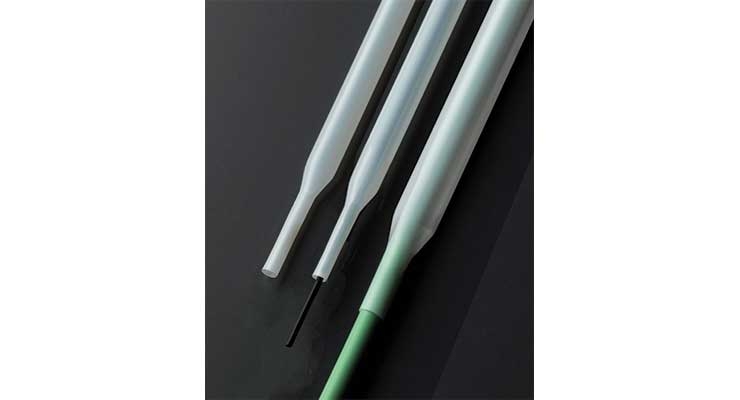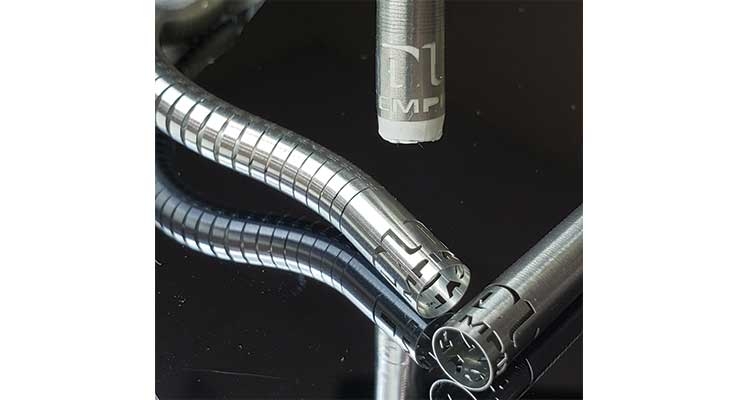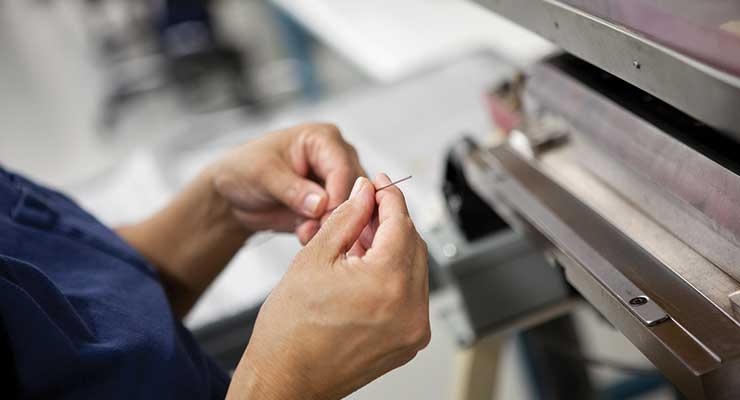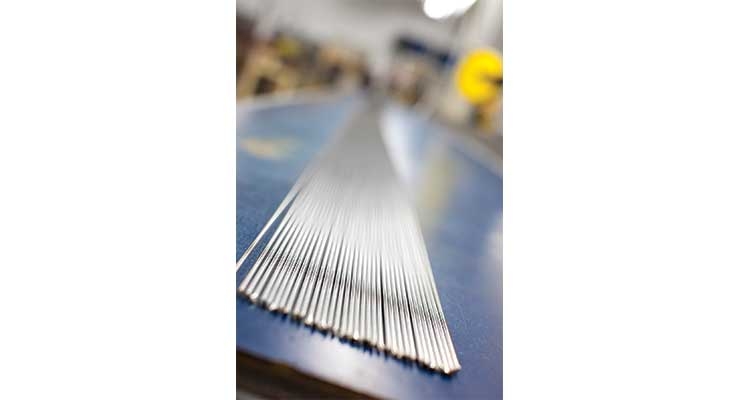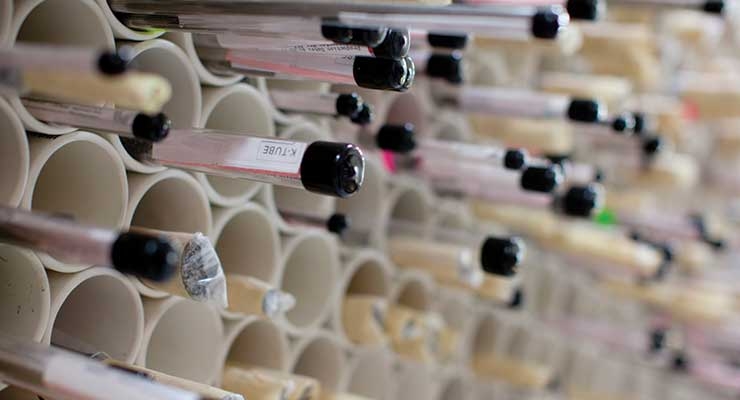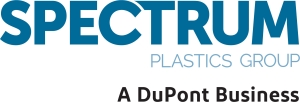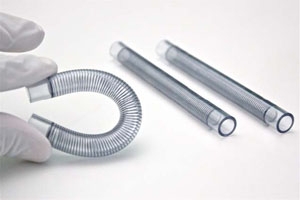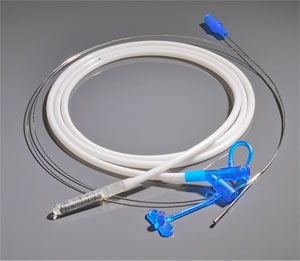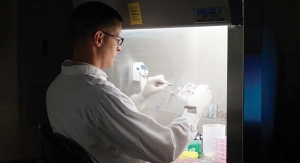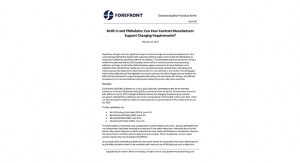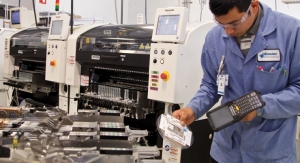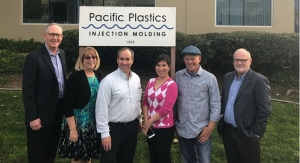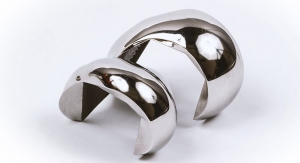Mark Crawford, Contributing Writer04.03.19
Extruded tubing and steel tubing are key components in medical devices today. Tubing applications continue to grow as medical device manufacturers (MDMs) create next-generation devices to improve a wide range of medical procedures. Medical instruments used in surgery today require more elaborate features and added functionality than they did in the past. As a result, product design and development have become more complex, including tubing components. The thermoplastic tubing market continues to expand due to the rapid growth of minimally invasive interventional therapies such as endovascular, cardiovascular, diagnostic, endoscopy, electrophysiology, structural heart, and other delivery systems. For example, such procedures often require catheters with multiple capabilities, such as sending electronic signals to smaller and harder-to-reach parts of the body.
According to a January 2019 report by Grand View Research, the value of the global medical plastic tubing market is expected to reach $11.95 billion by 2025 at a compound annual growth rate of 9.1 percent over the forecast period.1 The company predicts silicone polymers will be the fastest-growing segment, thanks to beneficial properties such as hydrophobicity, chemical resistance, and thermal stability. Silicone polymers are increasingly used in diagnostic guidewires, defibrillators, suture sleeves, and heart pumps.
“Silicone is being used in new and innovative ways in the medical device industry, such as overmolded tips, reinforced components, and novel extrusion profiles,” confirmed Paul Melnychuck, senior director of business development and innovation for Xeridiem Medical Devices, a Tucson, Ariz.-based supplier and a Spectrum Plastics Group company that manufactures silicone-based catheters and other components for medical devices.
Metal tubing is frequently used for the shafts of disposable and reusable medical instruments. OEMs want customized steel tubing with special properties for complex articulating instruments that enable easier access into the body during minimally invasive laparoscopic, endoscopic, and arthroscopic procedures. Making tubing components for these devices typically requires a variety of tubing technologies and processes to manipulate metals into different formations.
Robust growth in the extruded and steel tubing markets parallels the increased development of more complex, miniaturized, and multifunctional medical devices. New innovations in medical technologies and applications are forcing tubing providers to keep pace, where perhaps the greatest challenge is not technical but operational—how to add quality and functionality and still keep costs down. Advances in technology are enabling new procedures that were not possible before—as a result, OEMs are demanding creative, customized, thermoplastic and steel tubing solutions, especially for minimally invasive procedures.
“The market for medical tubing will continue to grow as more open surgical procedures are converted to less-invasive interventional procedures,” said Robert LaDuca, CEO of Duke Empirical, a Santa Cruz, Calif.-based manufacturer of catheters and precision medical tubing extrusion. “The rate of this conversion is limited by a lack of suitable, procedurally specific instruments that device developers actively pursue in areas of strategic interest, such as catheter-based mitral valve repair and replacement therapies.”
Extruded Tubing
OEMs are asking for smaller inner and outer diameters, multiple lumens, thinner walls, tighter tolerances, and color matching. They seek increasingly functional capabilities and greater performance from their tubing. These demands are pushing technological limits for new devices and next-generation redesigns—for example, OEMs want precision tolerances as small as ±0.0005 inches for outer diameter, inner diameter, and wall thicknesses.
Extrusion technology is being especially challenged by smaller and less invasive procedures that require very thin walls or smaller diameters (multi-lumen within smaller, tighter-tolerance tubes). This is driven primarily by the need for neurovascular techniques and below-the-knee procedures. To meet these demands, “catheter manufacturers are calling for innovations that reduce the wall thickness of the catheter liners to as small as 0.0006-0.0008 inches to free up real estate within the manufacturing of the catheter and to enable the efficient delivery of procedures such as a stent, balloons, coils, or ultrasound to the patient,” said Joe Rowan, president and CEO of Junkosha USA, an Irvine, Calif.-based provider of tubing and other products for medical devices.
OEMs are asking for customized tubing solutions with very precise material characteristics and performance parameters. Some tubes are designed to resist temperature and hazardous chemicals or reduce friction between the different catheter components. These challenges typically require the development of hybrid tubing innovations, whereby different layers of material serve different functions, or create variable properties along the length of the tube.
“There is always ongoing development on engineered polymers to provide specific performance characteristics, whether it is flexibility, biocompatibility, lubricity, or tensile,” said Tommy Thao, business development manager for Flexan, a Lincolnshire, Ill.-based provider of thermoplastic extrusions with bump tubing, tri-layer, coextrusion, and multi-lumen capabilities.
“Many new materials have been introduced over the last several years,” added Tim Steele, president and CEO of Microspec Corporation, a Peterborough, N.H.-based provider of custom extrusion for the medical device industry. “Some of these materials are formulated in the lab, specifically for one part and one application.”
The development of less-invasive heart valve repair and replacement technologies are driving the demand for catheter systems which meet demanding specialized requirements for transmitting forces to deploy implantable devices or to structurally modify the valve or its surrounding anulus while the practitioner operates the system a meter away using the catheter interface. Tubing for these applications has very specific requirements—for example, enough column strength to support “pushability” and navigation to the target anatomy through 3D access routes, while also having an axial stiffness that is sufficiently flexible to traverse tight radii without undo force being exerted on the access vessels. Similarly, once the device reaches the targeted anatomy, it must be stable during actuation and deployment forces, which may involve torque stability as well as in-plane stability, while still allowing motion to take place in only limited planes of motion. “Multi-material, multi-layer, deflectable, coil/braid/laser cut reinforcements, and lubricious liners and hydrophilic coatings are some of the more sophisticated tubing requirements OEMs are designing in order to achieve these goals,” said LaDuca.
As exciting as these enhanced capabilities are for these smaller and more complex devices, manufacturing costs can be expensive. MDMs exert great pressure on their tubing suppliers to control costs—a difficult challenge considering design and testing continue to become more elaborate, and often use more expensive advanced materials. Therefore, to keep costs down, suppliers are constantly looking for ways to increase efficiency across their operations, such as streamlining workflows. Junkosha has developed a 2.5:1 peelable heat shrink tubing (PHST) that provides catheter manufacturers with the highest shrink ratio currently possible in peelable fluorinated ethylene propylene (FEP), which reduces the number of shrink processes down to one. Thanks to its “take up,” 2.5:1 PHST allows the use of cost-effective, lower-tolerance, baseline materials in the manufacturing process, enabling easy reflow into a single smooth construct. Applications where this high-ratio PHST technology enables improved processes and cost savings include neurovascular catheters that have tapered diameters for the floppy distal segments and proximal sections with larger diameters for pushable support.
Tubing suppliers must also be up to date on regulatory requirements that pertain to their manufacturing processes and tubing products. More OEMs expect documentation that their tubing components meet ISO 13485:2016 standards for quality management, including validation and traceability. “As part of the development process, OEMs want process validation, which demonstrates statistically the part is what it’s supposed to be,” said Steele. “Delivering this type of service requires a highly-trained and reliable customer service department.”
Steel Tubing
Steel tubing for medical devices is typically manufactured using drawn tubing or a stamped and rolled technique. Selecting the most appropriate method depends on a number of factors, such as the medical device and its purpose, the size of the tubing required and its functional properties, and thickness and tolerance. Some OEMs are moving toward single-use surgical instruments and tubing components that can be discarded following a procedure, part of an approach to reduce the frequency of hospital-acquired infections (HAIs). Single-use instruments and tubing offer a safer approach to preventing transmission of infections, compared to reusable instruments that undergo repeated use and sterilization.
An increasing number of OEMs are being more selective in choosing raw materials. In the past, device engineers typically requested off-the-shelf catalog tubing because they could get it quickly. The downsides to this approach were the design compromises and the time it took to make the mating components work correctly. “Today, device engineers collaborate directly with our technical staff to design custom tubing that will improve device performance,” said Jeffrey Crane, application engineer for K-Tube Technologies, a Poway, Calif.-based producer of miniature stainless-steel tubing.
Orders for stainless-steel tubing are increasingly customized. Design teams seek specific physical properties in their steel tubing that can be achieved by using different alloys or by specifically engineered physical properties such as hardness, tensile strength, and stiffness, often in smaller dimensions with tighter tolerances and improved surface finishes. Ultra-small diameter tubing can have outer diameter sizes as small as 0.02 inches and inner diameter sizes as small as 0.005 inches.
Engineers want application-specific physical properties that give them a competitive advantage. This usually translates into using different alloys, but sometimes, it also involves pushing capabilities in manufacturing. “For example,” said Crane, “if we are tailoring properties for a catheter-based delivery system, we might recommend tubing with very high yield strengths, and then manufacture concurrent lots in Co-Cr alloys [MP35N, L605] or other precipitation-hardened alloys, such as 17-7PH or 1RK1, so the OEM can test torquability and pushability using different materials. Our teams are sourcing alloys that were once only available to the wire industry such as Co-Cr alloys, Ni-rich super alloys, and high-strength, precipitation-hardened alloys. We are actively researching and qualifying metal suppliers who can offer raw materials suitable for the manufacturing process.”
OEMs are also asking for shorter lead times for custom-designed tubing.
“Development requests are handled through our discover center, which is usually an engineer-to-engineer transaction that results in shorter manufacturing lead times,” said Crane. “Supply chain or operations professionals also need greater consistency from lot to lot, combined with risk-based regulatory compliance and lower costs. For these requests, we create proposals that increase lot sizes while balancing demand and supply, which often reduces variation and lowers manufacturing costs.”
Today, device engineers tend to collaborate directly with a tubing supplier’s technical staff to design custom tubing that will meet specific dimensions, tolerances, surface finishes, and physical properties like hardness, tensile strength, and stiffness. The best way for an OEM to secure the shortest possible lead times for custom-designed tubing is by working with a contract manufacturer (CM) that offers a full range of cost-effective, high-quality tubing solutions for the medical device industry, noted Steve Santoro, executive vice president for MICRO, a Somerset, N.J.-based manufacturer of medical devices featuring stainless steel tubing components. “OEMs that develop high-volume products are especially interested in innovative technologies that provide value and help them achieve more advanced features that are also cost-effective and efficient to produce,” said Santoro.
Design for manufacturability (DFM) services are an effective way to identify potential problems early in the design stage. DFM reduces prototyping iterations and smooths out the manufacturing process by eliminating unnecessary steps, which saves production time, money, frustration, and wasting valuable resources—all while speeding up time to market. “Being sensitive to pressures that design engineers face with cost targets, time to market, and other factors is critically important,” said Santoro. “We can step in during DFM when design engineers dismiss important manufacturing considerations, such as an overdesigned or under-designed product—which can prove detrimental to the successful production of parts.”
Technology Advances
Although advancements by tubing manufacturers are continuously being made, they are often proprietary in nature and deliberately kept off the radar. Continued research and development with existing extrusion technologies and/or new materials sometimes results in an effective new process, which remains in-house. This is true for both extruded tubing and stainless-steel tubing.
For example, OEMs want higher-quality cutting of burr-free ends on harder, thick-wall polymer tubing, compared to what standard rotary blade cutter/pullers can provide. Such tubing may be a hard polycarbonate or polyetheretherketone (PEEK) extrusion, which will be subsequently bonded. The cut ends on both sides must be perpendicular, without chips, cracks, loose debris, or flash, and with a cost that requires in-line cutting be performed during the extrusion process for efficiency at higher-volume requirements. To address this need, Duke developed an in-line precision radial cutting machine that moves along at the line speed while the cut is performed.
Medical device designers continue to be challenged to produce smaller and thinner micro catheters and guidewires, which provide clinicians with the ability to reach and treat previously inaccessible anatomical targets. Junkosha has developed an ultra-small PHST tubing suitable for laminating jacket coating to tiny guidewires with diameters as small as 0.011 inches. These miniature guidewires are ideal for applications such as navigating vessels to reach a lesion or vessel segment within the brain or heart.
Data collection and greater in-depth inspection requirements are becoming more prevalent for tubing. Control systems and in-line inspections are key to high-precision tubing production. “Control systems include better motors, servos, controls, feedback loops, and monitoring systems such as air, speed, and pressure,” said Thao. “In-line inspection is key because it reduces inspection, has real-time data/analysis, and provides feedback to the process for adjustments in process.”
Another technology improvement is the development of active catheters, which are being accepted more widely. Junkosha’s multi-channel transmission (MCT) catheter uses a cluster of simple microwires that are individually insulated with an innovative shielding/grounding construct, thereby increasing its signal capacity for a given size. Traditional catheters require four coaxial cables that run in parallel, carrying four individual signal streams; the MCT catheter enables multiples of four signals to be brought together in one cable, thereby quadrupling the capacity while still reducing the size of the catheter. MCT provides increased functionality compared to twisted pair coaxial and flexible printed circuit (FPC) technologies. MCT data-rich signals are especially beneficial for procedures such as intracardiac echocardiogram, ultrasound endoscopy, and intervascular ultrasound.
Inspection technologies must also advance to keep up with the increased number of smaller, more detailed features and components in medical devices, as well as manufacturing speed. Inspection equipment has come a long way in the last few years. Although pin gages and micrometers can still be useful, non-contact measurement both on-line and off-line is the preferred approach. Automation of measuring parts is advancing rapidly. “Some of the tubes we extrude have more than 100 points to measure,” said Steele. “Today’s programmable systems can inspect in minutes what would take an inspector all day to inspect and do it without subjectivity.”
Duke Empirical has invested in a new technology for automated defect detection from Taymer International that identifies, and sorts in-line for, visual defects as small as 0.05 mm. This system provides 100-percent visual inspection performed in-line at the extrusion line speed with programmable defect criteria and automatic data capture for all defects detected. The defect detection equipment sends a signal to the puller cutter, which then eliminates the defect in real time—for example, gels, bumps, particulate, grooves, scratches, and pinholes.
Steel-tubing manufacturers often work on new development projects with tolerances and sizes that are on the edge of current inspection equipment capabilities. K-Tube Technologies continues to improve its inspection capabilities by investing in new equipment such as multi-axis laser micrometers and ultra-sensitive material testing machines. The company is also developing a method for in-process, high-speed defect testing on straightened tubing of all sizes, which will improve tubing quality and reduce the non-conformance risk to customers. “Even with these advances, we spend a lot of effort working directly with our customers to correlate or create new inspection methods,” said Crane.
Innovation in Action
Growth in the tubing sector is fast-paced, with new, exciting innovations that drive OEMs to believe the impossible is actually possible. Medical device designs increasingly call for more functionality in smaller packages with thinner tube walls, more lumens, and even electrical transmission capabilities, with wires or cables embedded in tube walls. “A good example is our eTubing line,” said Derek Wilkins, regional sales manager for New England Tubing Technologies, a Lisbon, N.H.-based provider of tubing solutions and custom OEM components for medical devices. “Conductors with specific electrical requirements are built into the walls of tubing. This increases functionally of the design, reduces device footprint, and can reduce assembly time.”
The tubing can incorporate other components to meet specific OEM needs, such as ultra-miniature coaxial cables, high frequency cables, thermocouples, and high-strength/high-flex alloys to provide more functionality in the same tubular cross-section. Applications include analog and digital transmission of electrical signals for sensor capabilities, powering devices, and temperature/oxygen monitoring features.
Duke Empirical engineers faced the challenge of making a polytetrafluoroethylene (PTFE)-lined implant delivery catheter, where the distal section was required to be a soft 35D Pebax; however, because of the high radial force of the self-expanding nitinol implant, the catheter tip elongated when the sheath was retracted against the implant pusher during deployment. Wall thickness of the PTFE-lined, braid-reinforced distal section was 0.006 inches, with no allowance for increasing the outside diameter. “Since the design did not have sufficient room for axial aramid fibers, we instead developed a striped coextruded jacket that had a portion of the circumference in a harder durometer and stronger 72D material,” said LaDuca. “This solution did not increase the wall thickness and provided the additional strength needed, which then avoided the elongation previously seen during implant deployment.”
K-Tube Technologies was asked to develop a tube that could retain its cutting edge longer for multiple-use applications. Through material selection and processing, the engineering team was able to provide a tube that increased the hardness by 35 percent compared to conventional 304 stainless steel. For another application, a customer required tubing with a smooth interior-diameter surface finish to reduce the insertion forces on their stylet. “We recommended our plug-drawing process that supports and smooths the interior diameter during manufacturing, followed by testing different tolerance bands to find the right cost/benefit balance,” said Crane. “These process changes reduced insertion forces by over 50 percent.”
MICRO’s own tube mill for raw material and its patented rolled tube technology allow the company to reduce tubing costs (and shorten lifecycle) on disposable instruments through machining, bending, flaring, flanging, piercing, laser cutting, and other processes. An MDM approached MICRO to develop a cost-effective, disposable surgical device to be used in minimally invasive surgeries. MICRO used its proprietary process to manufacture a rolled tube in a progressive die that replaced traditional drawn tubing. This process streamlined secondary operations and reduced production time and component costs. “A finished tube can now be stamped in one second,” noted Santoro.
Moving Forward
Medical devices will continue to become smaller and more sophisticated, especially as new technologies expand the design options for medical device engineers and designers. OEMs want high-performing products with more challenging design features that make them stand out from the competition, all at a lower cost. To manufacture these new designs efficiently and cost effectively, tubing suppliers often make their own specialized equipment. For example, New England Tubing Technologies has built a custom machine and developed a unique process to support one item for one customer, as well as regularly develop unique tooling solutions to meet strict extrusion requirements.
The best way for MDMs to manufacture challenging tubing products is to align themselves with preferred vendors who can share their expertise and advise them during the design process. This is especially true for the often-complicated process of designing tubing components for laparoscopic procedures.
“Smaller tubes that provide greater maneuverability are in great demand for devices used for minimally invasive surgeries,” said Santoro. “Contract manufacturing organizations need to work with even greater attention to detail to keep production effective, efficient, and on time.”
For example, laser-cutting of steel tubing, which gives instruments the ability to articulate, also results in slugs which can be as small as a human hair. Removing these unwanted pieces of metal is a critical, challenging process. CMs should partner with their OEM customers during the design stage to ensure this process is properly controlled to prevent problems—for both the cutting machine and the final product itself.
The medical device industry continues to move rapidly toward customized work as devices become smaller and more complex. For example, MDMs have rapidly advanced from trying to make stock tubing work to regarding tubing as a design advantage. “A decade ago, most of our tubing sales were from our catalog,” said Crane, “but today, 90 percent of what K-Tube manufactures is custom tubing.”
In turn, K-Tube Technologies is expanding its capabilities to keep up with increasing technical demands. In the past year, it has developed ways to produce tubing with thinner walls (<0.0013 inches) without the use of centerless grinding and processed parts with a bright/mirror interior-diameter surface finish at smaller sizes than previously possible.
Duke Empirical is also advancing its own in-house technologies to enable new clinical applications and offer device developers new tools to access the human body for the diagnosis and treatment of diseases. “By taking advantage of new tubing materials, tubing product design, and processes, innovative companies will usher in a new class of tubing for devices that have specialized properties and specific uses, such as optimized fluid management,” said LaDuca.
When it comes to overcoming tubing challenges, the experience of the processor is critical to solving the problem in a cost-effective way. The processor with relevant experience can use a methodological approach to problem solving such investigating the raw material, the process, or the specification. Often times processors are asked to do something new or to push the known limits and try a different approach to overcoming past obstacles.
For example, Duke Empirical recently ran a very soft elastic material with a 5A durometer. “This material elastically stretches over 2,700 percent and is tacky and creates processing challenges including wrapping around the puller belts with wall thicknesses as small as 0.003 inches,” said LaDuca. “Fortunately we could draw on our experience of running other less extreme materials to optimize our equipment set up to produce a capable process. Working with the fundamental principles helps guide the iterative solution process by trying the simplest and most applicable ideas first while moving up in complexity as required until a solution is obtained. Of course, there may be more than one solution and not every problem is worth solving so the need and desire to obtain a solution should justify the economic investment required to solve the problem.”
“Value is often misunderstood,” reflected Santoro. “It isn’t always about the lowest price; instead it is about producing the most cost-effective and efficient product that will be profitable. OEMs and their CM partners need to work together, early in the development cycle to ensure a product can be manufactured in a way that meets OEM goals. Design for manufacturability can help realize the optimal cost to repeatably produce a functional, compliant product. OEMs need to involve the CM early in the design phase to leverage the CM’s expertise and minimize the risk of having to undergo multiple design iterations, which are costly and time-consuming. A successful partnership is essential for ensuring quality and value in product development and production.”
Reference
Mark Crawford is a full-time freelance business and marketing/communications writer based in Madison, Wis. His clients range from startups to global manufacturing leaders. He also writes a variety of feature articles for regional and national publications and is the author of five books.
According to a January 2019 report by Grand View Research, the value of the global medical plastic tubing market is expected to reach $11.95 billion by 2025 at a compound annual growth rate of 9.1 percent over the forecast period.1 The company predicts silicone polymers will be the fastest-growing segment, thanks to beneficial properties such as hydrophobicity, chemical resistance, and thermal stability. Silicone polymers are increasingly used in diagnostic guidewires, defibrillators, suture sleeves, and heart pumps.
“Silicone is being used in new and innovative ways in the medical device industry, such as overmolded tips, reinforced components, and novel extrusion profiles,” confirmed Paul Melnychuck, senior director of business development and innovation for Xeridiem Medical Devices, a Tucson, Ariz.-based supplier and a Spectrum Plastics Group company that manufactures silicone-based catheters and other components for medical devices.
Metal tubing is frequently used for the shafts of disposable and reusable medical instruments. OEMs want customized steel tubing with special properties for complex articulating instruments that enable easier access into the body during minimally invasive laparoscopic, endoscopic, and arthroscopic procedures. Making tubing components for these devices typically requires a variety of tubing technologies and processes to manipulate metals into different formations.
Robust growth in the extruded and steel tubing markets parallels the increased development of more complex, miniaturized, and multifunctional medical devices. New innovations in medical technologies and applications are forcing tubing providers to keep pace, where perhaps the greatest challenge is not technical but operational—how to add quality and functionality and still keep costs down. Advances in technology are enabling new procedures that were not possible before—as a result, OEMs are demanding creative, customized, thermoplastic and steel tubing solutions, especially for minimally invasive procedures.
“The market for medical tubing will continue to grow as more open surgical procedures are converted to less-invasive interventional procedures,” said Robert LaDuca, CEO of Duke Empirical, a Santa Cruz, Calif.-based manufacturer of catheters and precision medical tubing extrusion. “The rate of this conversion is limited by a lack of suitable, procedurally specific instruments that device developers actively pursue in areas of strategic interest, such as catheter-based mitral valve repair and replacement therapies.”
Extruded Tubing
OEMs are asking for smaller inner and outer diameters, multiple lumens, thinner walls, tighter tolerances, and color matching. They seek increasingly functional capabilities and greater performance from their tubing. These demands are pushing technological limits for new devices and next-generation redesigns—for example, OEMs want precision tolerances as small as ±0.0005 inches for outer diameter, inner diameter, and wall thicknesses.
Extrusion technology is being especially challenged by smaller and less invasive procedures that require very thin walls or smaller diameters (multi-lumen within smaller, tighter-tolerance tubes). This is driven primarily by the need for neurovascular techniques and below-the-knee procedures. To meet these demands, “catheter manufacturers are calling for innovations that reduce the wall thickness of the catheter liners to as small as 0.0006-0.0008 inches to free up real estate within the manufacturing of the catheter and to enable the efficient delivery of procedures such as a stent, balloons, coils, or ultrasound to the patient,” said Joe Rowan, president and CEO of Junkosha USA, an Irvine, Calif.-based provider of tubing and other products for medical devices.
OEMs are asking for customized tubing solutions with very precise material characteristics and performance parameters. Some tubes are designed to resist temperature and hazardous chemicals or reduce friction between the different catheter components. These challenges typically require the development of hybrid tubing innovations, whereby different layers of material serve different functions, or create variable properties along the length of the tube.
“There is always ongoing development on engineered polymers to provide specific performance characteristics, whether it is flexibility, biocompatibility, lubricity, or tensile,” said Tommy Thao, business development manager for Flexan, a Lincolnshire, Ill.-based provider of thermoplastic extrusions with bump tubing, tri-layer, coextrusion, and multi-lumen capabilities.
“Many new materials have been introduced over the last several years,” added Tim Steele, president and CEO of Microspec Corporation, a Peterborough, N.H.-based provider of custom extrusion for the medical device industry. “Some of these materials are formulated in the lab, specifically for one part and one application.”
The development of less-invasive heart valve repair and replacement technologies are driving the demand for catheter systems which meet demanding specialized requirements for transmitting forces to deploy implantable devices or to structurally modify the valve or its surrounding anulus while the practitioner operates the system a meter away using the catheter interface. Tubing for these applications has very specific requirements—for example, enough column strength to support “pushability” and navigation to the target anatomy through 3D access routes, while also having an axial stiffness that is sufficiently flexible to traverse tight radii without undo force being exerted on the access vessels. Similarly, once the device reaches the targeted anatomy, it must be stable during actuation and deployment forces, which may involve torque stability as well as in-plane stability, while still allowing motion to take place in only limited planes of motion. “Multi-material, multi-layer, deflectable, coil/braid/laser cut reinforcements, and lubricious liners and hydrophilic coatings are some of the more sophisticated tubing requirements OEMs are designing in order to achieve these goals,” said LaDuca.
As exciting as these enhanced capabilities are for these smaller and more complex devices, manufacturing costs can be expensive. MDMs exert great pressure on their tubing suppliers to control costs—a difficult challenge considering design and testing continue to become more elaborate, and often use more expensive advanced materials. Therefore, to keep costs down, suppliers are constantly looking for ways to increase efficiency across their operations, such as streamlining workflows. Junkosha has developed a 2.5:1 peelable heat shrink tubing (PHST) that provides catheter manufacturers with the highest shrink ratio currently possible in peelable fluorinated ethylene propylene (FEP), which reduces the number of shrink processes down to one. Thanks to its “take up,” 2.5:1 PHST allows the use of cost-effective, lower-tolerance, baseline materials in the manufacturing process, enabling easy reflow into a single smooth construct. Applications where this high-ratio PHST technology enables improved processes and cost savings include neurovascular catheters that have tapered diameters for the floppy distal segments and proximal sections with larger diameters for pushable support.
Tubing suppliers must also be up to date on regulatory requirements that pertain to their manufacturing processes and tubing products. More OEMs expect documentation that their tubing components meet ISO 13485:2016 standards for quality management, including validation and traceability. “As part of the development process, OEMs want process validation, which demonstrates statistically the part is what it’s supposed to be,” said Steele. “Delivering this type of service requires a highly-trained and reliable customer service department.”
Steel Tubing
Steel tubing for medical devices is typically manufactured using drawn tubing or a stamped and rolled technique. Selecting the most appropriate method depends on a number of factors, such as the medical device and its purpose, the size of the tubing required and its functional properties, and thickness and tolerance. Some OEMs are moving toward single-use surgical instruments and tubing components that can be discarded following a procedure, part of an approach to reduce the frequency of hospital-acquired infections (HAIs). Single-use instruments and tubing offer a safer approach to preventing transmission of infections, compared to reusable instruments that undergo repeated use and sterilization.
An increasing number of OEMs are being more selective in choosing raw materials. In the past, device engineers typically requested off-the-shelf catalog tubing because they could get it quickly. The downsides to this approach were the design compromises and the time it took to make the mating components work correctly. “Today, device engineers collaborate directly with our technical staff to design custom tubing that will improve device performance,” said Jeffrey Crane, application engineer for K-Tube Technologies, a Poway, Calif.-based producer of miniature stainless-steel tubing.
Orders for stainless-steel tubing are increasingly customized. Design teams seek specific physical properties in their steel tubing that can be achieved by using different alloys or by specifically engineered physical properties such as hardness, tensile strength, and stiffness, often in smaller dimensions with tighter tolerances and improved surface finishes. Ultra-small diameter tubing can have outer diameter sizes as small as 0.02 inches and inner diameter sizes as small as 0.005 inches.
Engineers want application-specific physical properties that give them a competitive advantage. This usually translates into using different alloys, but sometimes, it also involves pushing capabilities in manufacturing. “For example,” said Crane, “if we are tailoring properties for a catheter-based delivery system, we might recommend tubing with very high yield strengths, and then manufacture concurrent lots in Co-Cr alloys [MP35N, L605] or other precipitation-hardened alloys, such as 17-7PH or 1RK1, so the OEM can test torquability and pushability using different materials. Our teams are sourcing alloys that were once only available to the wire industry such as Co-Cr alloys, Ni-rich super alloys, and high-strength, precipitation-hardened alloys. We are actively researching and qualifying metal suppliers who can offer raw materials suitable for the manufacturing process.”
OEMs are also asking for shorter lead times for custom-designed tubing.
“Development requests are handled through our discover center, which is usually an engineer-to-engineer transaction that results in shorter manufacturing lead times,” said Crane. “Supply chain or operations professionals also need greater consistency from lot to lot, combined with risk-based regulatory compliance and lower costs. For these requests, we create proposals that increase lot sizes while balancing demand and supply, which often reduces variation and lowers manufacturing costs.”
Today, device engineers tend to collaborate directly with a tubing supplier’s technical staff to design custom tubing that will meet specific dimensions, tolerances, surface finishes, and physical properties like hardness, tensile strength, and stiffness. The best way for an OEM to secure the shortest possible lead times for custom-designed tubing is by working with a contract manufacturer (CM) that offers a full range of cost-effective, high-quality tubing solutions for the medical device industry, noted Steve Santoro, executive vice president for MICRO, a Somerset, N.J.-based manufacturer of medical devices featuring stainless steel tubing components. “OEMs that develop high-volume products are especially interested in innovative technologies that provide value and help them achieve more advanced features that are also cost-effective and efficient to produce,” said Santoro.
Design for manufacturability (DFM) services are an effective way to identify potential problems early in the design stage. DFM reduces prototyping iterations and smooths out the manufacturing process by eliminating unnecessary steps, which saves production time, money, frustration, and wasting valuable resources—all while speeding up time to market. “Being sensitive to pressures that design engineers face with cost targets, time to market, and other factors is critically important,” said Santoro. “We can step in during DFM when design engineers dismiss important manufacturing considerations, such as an overdesigned or under-designed product—which can prove detrimental to the successful production of parts.”
Technology Advances
Although advancements by tubing manufacturers are continuously being made, they are often proprietary in nature and deliberately kept off the radar. Continued research and development with existing extrusion technologies and/or new materials sometimes results in an effective new process, which remains in-house. This is true for both extruded tubing and stainless-steel tubing.
For example, OEMs want higher-quality cutting of burr-free ends on harder, thick-wall polymer tubing, compared to what standard rotary blade cutter/pullers can provide. Such tubing may be a hard polycarbonate or polyetheretherketone (PEEK) extrusion, which will be subsequently bonded. The cut ends on both sides must be perpendicular, without chips, cracks, loose debris, or flash, and with a cost that requires in-line cutting be performed during the extrusion process for efficiency at higher-volume requirements. To address this need, Duke developed an in-line precision radial cutting machine that moves along at the line speed while the cut is performed.
Medical device designers continue to be challenged to produce smaller and thinner micro catheters and guidewires, which provide clinicians with the ability to reach and treat previously inaccessible anatomical targets. Junkosha has developed an ultra-small PHST tubing suitable for laminating jacket coating to tiny guidewires with diameters as small as 0.011 inches. These miniature guidewires are ideal for applications such as navigating vessels to reach a lesion or vessel segment within the brain or heart.
Data collection and greater in-depth inspection requirements are becoming more prevalent for tubing. Control systems and in-line inspections are key to high-precision tubing production. “Control systems include better motors, servos, controls, feedback loops, and monitoring systems such as air, speed, and pressure,” said Thao. “In-line inspection is key because it reduces inspection, has real-time data/analysis, and provides feedback to the process for adjustments in process.”
Another technology improvement is the development of active catheters, which are being accepted more widely. Junkosha’s multi-channel transmission (MCT) catheter uses a cluster of simple microwires that are individually insulated with an innovative shielding/grounding construct, thereby increasing its signal capacity for a given size. Traditional catheters require four coaxial cables that run in parallel, carrying four individual signal streams; the MCT catheter enables multiples of four signals to be brought together in one cable, thereby quadrupling the capacity while still reducing the size of the catheter. MCT provides increased functionality compared to twisted pair coaxial and flexible printed circuit (FPC) technologies. MCT data-rich signals are especially beneficial for procedures such as intracardiac echocardiogram, ultrasound endoscopy, and intervascular ultrasound.
Inspection technologies must also advance to keep up with the increased number of smaller, more detailed features and components in medical devices, as well as manufacturing speed. Inspection equipment has come a long way in the last few years. Although pin gages and micrometers can still be useful, non-contact measurement both on-line and off-line is the preferred approach. Automation of measuring parts is advancing rapidly. “Some of the tubes we extrude have more than 100 points to measure,” said Steele. “Today’s programmable systems can inspect in minutes what would take an inspector all day to inspect and do it without subjectivity.”
Duke Empirical has invested in a new technology for automated defect detection from Taymer International that identifies, and sorts in-line for, visual defects as small as 0.05 mm. This system provides 100-percent visual inspection performed in-line at the extrusion line speed with programmable defect criteria and automatic data capture for all defects detected. The defect detection equipment sends a signal to the puller cutter, which then eliminates the defect in real time—for example, gels, bumps, particulate, grooves, scratches, and pinholes.
Steel-tubing manufacturers often work on new development projects with tolerances and sizes that are on the edge of current inspection equipment capabilities. K-Tube Technologies continues to improve its inspection capabilities by investing in new equipment such as multi-axis laser micrometers and ultra-sensitive material testing machines. The company is also developing a method for in-process, high-speed defect testing on straightened tubing of all sizes, which will improve tubing quality and reduce the non-conformance risk to customers. “Even with these advances, we spend a lot of effort working directly with our customers to correlate or create new inspection methods,” said Crane.
Innovation in Action
Growth in the tubing sector is fast-paced, with new, exciting innovations that drive OEMs to believe the impossible is actually possible. Medical device designs increasingly call for more functionality in smaller packages with thinner tube walls, more lumens, and even electrical transmission capabilities, with wires or cables embedded in tube walls. “A good example is our eTubing line,” said Derek Wilkins, regional sales manager for New England Tubing Technologies, a Lisbon, N.H.-based provider of tubing solutions and custom OEM components for medical devices. “Conductors with specific electrical requirements are built into the walls of tubing. This increases functionally of the design, reduces device footprint, and can reduce assembly time.”
The tubing can incorporate other components to meet specific OEM needs, such as ultra-miniature coaxial cables, high frequency cables, thermocouples, and high-strength/high-flex alloys to provide more functionality in the same tubular cross-section. Applications include analog and digital transmission of electrical signals for sensor capabilities, powering devices, and temperature/oxygen monitoring features.
Duke Empirical engineers faced the challenge of making a polytetrafluoroethylene (PTFE)-lined implant delivery catheter, where the distal section was required to be a soft 35D Pebax; however, because of the high radial force of the self-expanding nitinol implant, the catheter tip elongated when the sheath was retracted against the implant pusher during deployment. Wall thickness of the PTFE-lined, braid-reinforced distal section was 0.006 inches, with no allowance for increasing the outside diameter. “Since the design did not have sufficient room for axial aramid fibers, we instead developed a striped coextruded jacket that had a portion of the circumference in a harder durometer and stronger 72D material,” said LaDuca. “This solution did not increase the wall thickness and provided the additional strength needed, which then avoided the elongation previously seen during implant deployment.”
K-Tube Technologies was asked to develop a tube that could retain its cutting edge longer for multiple-use applications. Through material selection and processing, the engineering team was able to provide a tube that increased the hardness by 35 percent compared to conventional 304 stainless steel. For another application, a customer required tubing with a smooth interior-diameter surface finish to reduce the insertion forces on their stylet. “We recommended our plug-drawing process that supports and smooths the interior diameter during manufacturing, followed by testing different tolerance bands to find the right cost/benefit balance,” said Crane. “These process changes reduced insertion forces by over 50 percent.”
MICRO’s own tube mill for raw material and its patented rolled tube technology allow the company to reduce tubing costs (and shorten lifecycle) on disposable instruments through machining, bending, flaring, flanging, piercing, laser cutting, and other processes. An MDM approached MICRO to develop a cost-effective, disposable surgical device to be used in minimally invasive surgeries. MICRO used its proprietary process to manufacture a rolled tube in a progressive die that replaced traditional drawn tubing. This process streamlined secondary operations and reduced production time and component costs. “A finished tube can now be stamped in one second,” noted Santoro.
Moving Forward
Medical devices will continue to become smaller and more sophisticated, especially as new technologies expand the design options for medical device engineers and designers. OEMs want high-performing products with more challenging design features that make them stand out from the competition, all at a lower cost. To manufacture these new designs efficiently and cost effectively, tubing suppliers often make their own specialized equipment. For example, New England Tubing Technologies has built a custom machine and developed a unique process to support one item for one customer, as well as regularly develop unique tooling solutions to meet strict extrusion requirements.
The best way for MDMs to manufacture challenging tubing products is to align themselves with preferred vendors who can share their expertise and advise them during the design process. This is especially true for the often-complicated process of designing tubing components for laparoscopic procedures.
“Smaller tubes that provide greater maneuverability are in great demand for devices used for minimally invasive surgeries,” said Santoro. “Contract manufacturing organizations need to work with even greater attention to detail to keep production effective, efficient, and on time.”
For example, laser-cutting of steel tubing, which gives instruments the ability to articulate, also results in slugs which can be as small as a human hair. Removing these unwanted pieces of metal is a critical, challenging process. CMs should partner with their OEM customers during the design stage to ensure this process is properly controlled to prevent problems—for both the cutting machine and the final product itself.
The medical device industry continues to move rapidly toward customized work as devices become smaller and more complex. For example, MDMs have rapidly advanced from trying to make stock tubing work to regarding tubing as a design advantage. “A decade ago, most of our tubing sales were from our catalog,” said Crane, “but today, 90 percent of what K-Tube manufactures is custom tubing.”
In turn, K-Tube Technologies is expanding its capabilities to keep up with increasing technical demands. In the past year, it has developed ways to produce tubing with thinner walls (<0.0013 inches) without the use of centerless grinding and processed parts with a bright/mirror interior-diameter surface finish at smaller sizes than previously possible.
Duke Empirical is also advancing its own in-house technologies to enable new clinical applications and offer device developers new tools to access the human body for the diagnosis and treatment of diseases. “By taking advantage of new tubing materials, tubing product design, and processes, innovative companies will usher in a new class of tubing for devices that have specialized properties and specific uses, such as optimized fluid management,” said LaDuca.
When it comes to overcoming tubing challenges, the experience of the processor is critical to solving the problem in a cost-effective way. The processor with relevant experience can use a methodological approach to problem solving such investigating the raw material, the process, or the specification. Often times processors are asked to do something new or to push the known limits and try a different approach to overcoming past obstacles.
For example, Duke Empirical recently ran a very soft elastic material with a 5A durometer. “This material elastically stretches over 2,700 percent and is tacky and creates processing challenges including wrapping around the puller belts with wall thicknesses as small as 0.003 inches,” said LaDuca. “Fortunately we could draw on our experience of running other less extreme materials to optimize our equipment set up to produce a capable process. Working with the fundamental principles helps guide the iterative solution process by trying the simplest and most applicable ideas first while moving up in complexity as required until a solution is obtained. Of course, there may be more than one solution and not every problem is worth solving so the need and desire to obtain a solution should justify the economic investment required to solve the problem.”
“Value is often misunderstood,” reflected Santoro. “It isn’t always about the lowest price; instead it is about producing the most cost-effective and efficient product that will be profitable. OEMs and their CM partners need to work together, early in the development cycle to ensure a product can be manufactured in a way that meets OEM goals. Design for manufacturability can help realize the optimal cost to repeatably produce a functional, compliant product. OEMs need to involve the CM early in the design phase to leverage the CM’s expertise and minimize the risk of having to undergo multiple design iterations, which are costly and time-consuming. A successful partnership is essential for ensuring quality and value in product development and production.”
Reference
Mark Crawford is a full-time freelance business and marketing/communications writer based in Madison, Wis. His clients range from startups to global manufacturing leaders. He also writes a variety of feature articles for regional and national publications and is the author of five books.

